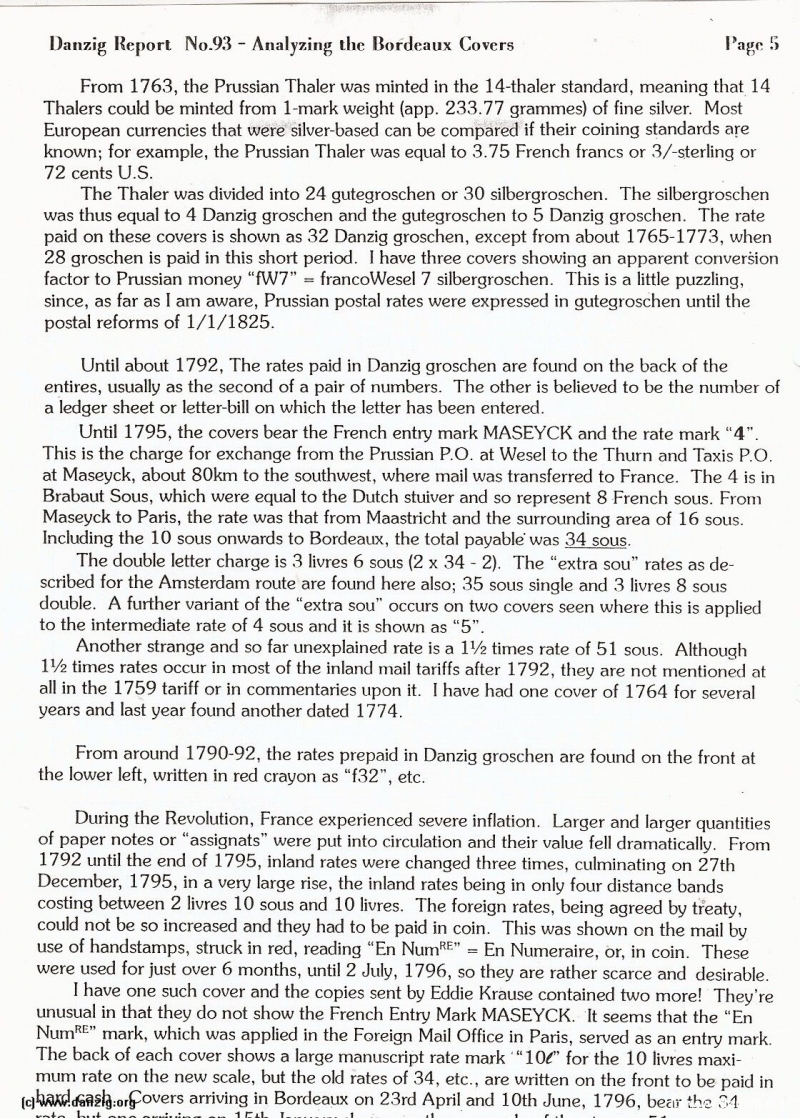
From 1763, the Prussian Thaler was minted in the 14-thaler standard, meaning that 14 Thalers could be minted from 1-mark weight (app. 233.77 grammes of fine silver. Most European currencies that were silver-based can be compared if their coining standards are known; for example, the Prussian Thaler was equal to 3.75 French francs or 3/-sterling or 72 cents U.S.
The Thaler was divided into 24 gutegroschen or 30 silbergroschen. The silbergroschen was thus equal to 4 Danzig groschen and the gutegroschen to 5 Danzig groschen. The rate paid on these covers is shown as 32 Danzig groschen, except from about 1765-1773, when 28 groschen is paid in this short period. I have three covers showing an apparent conversion factor to Prussian money “fW7” = francoWesel 7 silbergroschen. This is a little puzzling, since, as far as I am aware, Prussian postal rates were expressed in gutegroschen until the postal reforms of 1/1/1825.
Until about 1792, The rates paid in Danzig groschen are found on the back of the entires, usually as the second of a pair of numbers. The other is believed to be the number of a ledger sheet or letter-bill on which the letter has been entered.
Until 1795, the covers bear the French entry mark MASEYCK and the rate mark ‘4’. This is the charge for exchange from the Prussian P.O. at Wesel to the Thurn and Taxis P.O. at Maseyck, about 80km to the southwest, where mail was transferred to France. The 4 is in Brabaut Sous, which were equal to the Dutch stuiver and so represent 8 French sous. From Maseyck to Paris, the rate was that from Maastricht and the surrounding area of 16 sous. Including the 10 sous onwards to Bordeaux, the total payable was 34 sous.
The double letter charge is 3 livres 6 sous (2 x 34 - 2). The “extra sou” rates as des cribed for the Amsterdam route are found here also; 35 sous single and 3 livres 8 sons double. A further variant of the “extra sou” occurs on two covers seen where this is applied to the intermediate rate of 4 sous and it is shown as “5”.
Another strange and so far unexplained rate is a 1½ times rate of 51 sous. Although 1½ times rates occur in most of the inland mail tariffs after 1792, they are not mentioned at all in the 1759 tariff or in commentaries upon it. I have had one cover of 1764 for several years and last year found another dated 1774.
From around 1790-92, the rates prepaid in Danzig groschen are found on the front at the lower left, written in red crayon as “f32”, etc.
During the Revolution, France experienced severe inflation. Larger and larger quantities of paper notes or “assignats” were put into circulation and their value fell dramatically. From 1792 until the end of 1795, inland rates were changed three times, culminating on 27th December, 1795, in a very large rise, the inland rates being in only four distance bands costing between 2 livres 10 sous and 10 livres. The foreign rates, being agreed by treaty, could not be so increased and they had to be paid in coin. This was shown on the mail by use of handstamps, struck in red, reading “En Num” = En Numeraire, or, in coin. These were used for just over 6 months, until 2 July, 1796, so they are rather scarce and desirable.
I have one such cover and the copies sent by Eddie Krause contained two more! They’re unusual in that they do not show the French Entry Mark MASEYCK. It seems that the “En Num1” mark, which was applied in the Foreign Mail Office in Paris, served as an entry mark. The back of each cover shows a large manuscript rate mark for the 10 livres maxim um rate on the new scale, but the old rates of 34, etc., are written on the front to be paid in hard cash. Covers arriving in Bordeaux on 23rd April and 10th June, 1796, bear the 34
Danzig Report Vol. 1 - Nr. 93 - October - November - December - 1996, Page 5.
Hits: 3660
Added: 19/07/2015
Copyright: 2025 Danzig.org

